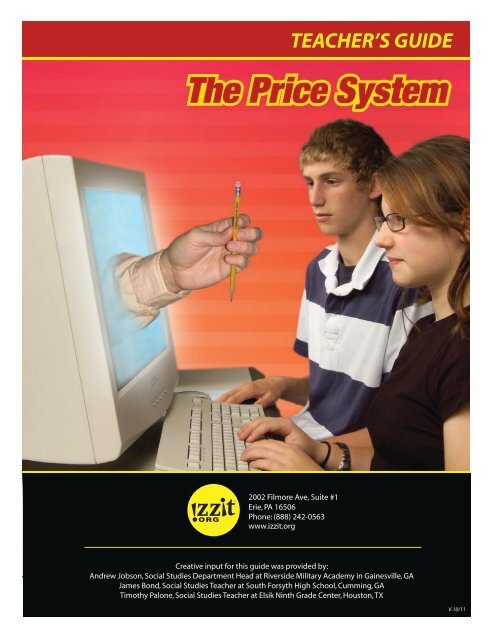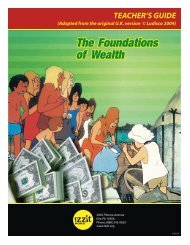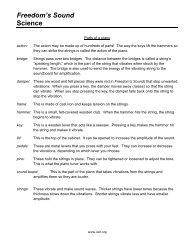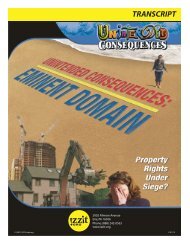The Price System - Izzit.org
The Price System - Izzit.org
The Price System - Izzit.org
- No tags were found...
You also want an ePaper? Increase the reach of your titles
YUMPU automatically turns print PDFs into web optimized ePapers that Google loves.
TEACHER’S GUIDE2002 Filmore Ave, Suite #1Erie, PA 16506Phone: (888) 242-0563www.izzit.<strong>org</strong>Creative input for this guide was provided by:Andrew Jobson, Social Studies Department Head at Riverside Military Academy in Gainesville, GAJames Bond, Social Studies Teacher at South Forsyth High School, Cumming, GATimothy Palone, Social Studies Teacher at Elsik Ninth Grade Center, Houston, TXV.10/11
IntroductionThis video is presented in two segments. For each segment, this Teacher’s Guide provides:• Sample worksheets for easy photocopying• Class discussion questions• Post-video quiz• Extra credit ideas and post viewing activitiesA suggested lesson plan progression…• Distribute “Worksheet: Segment 1” and view Segment 1. Discuss students’ responses. Assignas homework or class project a “Post Viewing Activity.”• Repeat for Segment 2 and cover discussion questions.• Administer post-video quiz.2
THE PRICE SYSTEMThis video borrows heavily from Leonard Read’s classic essay, “I, Pencil: My Family Story as told toLeonard E. Read” (1958). <strong>The</strong> essay is available at www.econlib.<strong>org</strong>/library/Essays/rdPncl1.html.Mr. Read was the founder and first president of the Foundation for Economic Education(www.fee.<strong>org</strong>), which publishes a monthly journal called <strong>The</strong> Freeman.<strong>The</strong> speaker in the video, Milton Friedman, is a Nobel Prize-winning economist who begins his classictreatise, Free to Choose, with a summary of “I, Pencil” and an examination of the price system. (SeeChapter One, “<strong>The</strong> Power of the Market.”) This chapter, and indeed the entire book, is highlyrecommended for those wishing to pursue more information about the concepts outlined in the video.Key ConceptsThis video makes use of or refers to the following key economic concepts:Adam Smith is considered the founder of modern economics. As Friedman says in Free to Choose,Smith’s “key insight” in his treatise <strong>The</strong> Wealth of Nations was that voluntary exchange meant thatboth parties could benefit. As individuals pursued their own gain, they contributed to society’s gain(as if guided by an invisible hand). This was most true in an environment of personal and politicalfreedom, where decisions were guided by the price system.<strong>Price</strong>s work in THREE ways: to transmit information, to serve as incentives for production, and todetermine the distribution of income. Some examples of how these work:1. Transmitting information: If supply is disrupted, for example, producers may charge more.If prices rise, consumers may look for substitute products, restoring equilibrium betweensupply and demand.2. Incentives for production: A product that is in short supply will see prices rise; this mayallow for higher wages in that industry. Higher wages will attract more labor to meet theneed.3. Distributing income: Wages and salary (the ‘price’ of labor) and other income result fromchoices. Occupations in low supply, especially those that require high degrees of trainingand skill, attract workers by offering higher incomes. Occupations that are oversupplied orunnecessary see their relative value drop.One of the keys to economic growth is productivity. Smith argued that the division of labor, orspecialization, was key to increasing productivity. This video shows that no one knows how to makea pencil because no one has the capacity to know all there is to know to accomplish that goal. <strong>The</strong>price system allows people to specialize on a portion of the job, say the chemistry of making steel,which an individual can come to understand AND IMPROVE UPON, thus progress is made andcomplicated products are manufactured.Coercion or other means of manipulating the system (governmental or otherwise) corrupt it. Becauseof human ingenuity, wealth is NOT a zero-sum game, where one party gains and one party loses incompetition for a permanently defined piece of “economic pie.” Instead, new wealth can be created;this occurs best when political, personal, and economic freedoms intersect. Of course, government isnecessary, particularly when providing goods and services that individuals can’t or won’t pay for ontheir own (national security, for example). Such goods, paid for with taxes, are known as publicgoods.3
Name:Date:Post Viewing Activities: Segment 11. Using the CIA Factbook, provide a list of nations that follow a free market economy,a traditional economy, and a command economy. Include a map showing the location of each.2. Make a list of every country mentioned in the production of a pencil. Using the map provided,label each country listed. What trade patterns do you see? Explain.3. Division of Labor Simulation:Stage 1: Provide students with the dimensions of a paper house (below), and ask them to gather theneeded resources at the front of the room. Each student will work to produce the most houses in agiven time (recommended time is 20 minutes).Stage 2: Now divide the class into four groups, with each specializing in one part of the house:front/back walls, side walls, roofs and assembly. <strong>The</strong> same amount of time is given.Result: Students will see that Stage 2 produced a larger quantity of houses in the same amount oftime. This illustrates the efficiency of the division of labor.Materials needed: Scissors, cellophane tape and construction paper.Suggested shape:5 “ 5 “ 2 sidewalls5 “5 “ 5 “5 “5 “7“Roof7”10”5
Name:Date:Worksheet: 2Segment 21. What is the price system?2. Milton Friedman says the price system adds to world co-operation. Explain.3. How does the price system facilitate supply and demand? What three key pieces of information does theprice system provide?4. How does the price system enhance creativity and progress?5. What is the “zero sum game” philosophy? How is it different from the concept of the invisible hand?6. Do you agree that wealth is a “fixed pie”? In other words, are you necessarily worse off if I make moremoney as your teacher? Why or why not?What might happen if the government creates artificial requirements governing all purchasing transactions?What might happen if these governmental restraints were removed? Would these goods and servicesdisappear from the market? Explain.How are the concepts of a free market, personal, economic and political freedom interrelated?6
Additional Discussion Questions: Segments 1-21. Human capital is defined as investment in education and skills. How could human capital beimproved to enhance the production of pencils?2. Using information from the video, explain how scarce resources are most efficiently allocated.3. For the pencil to make it to Staples, what has to happen? How many other kinds of industries areinvolved?4. Consider for a moment the concepts of a free market economy, personal, political and economicfreedom. Which one is most important to you? Which one is the least important? Can you foreseeone existing without the other? Explain.5. Are there areas in which the government MUST be involved? In your opinion, when should agovernment spend tax dollars to provide goods and/or services for its citizens?8
Name:Date:QuizPart I. Fill in the blanks with the appropriate terms:1. In a free market, people trade for goods and services through a system known as_______________ exchange. Because of this, both sides feel better off as a result of the trade.2. Dr. Friedman argues that free markets and political and personal ____________ are linked, andthat the best possible system embraces all three.3. Adam Smith described an _____________ _________ which “governed” the market without acentral “mastermind.”4. Without central or government planning, the machinery that enables peaceful cooperation andeconomic growth is the ________ ____________.5. Dr. Friedman argues that one major fallacy in economic thinking is the belief that wealth is a_________-____ _________.Part II: Answer in a few sentences.1. How did the behavior of Emily and Emerson demonstrate the economic concepts in the video?2. We can all name the ‘parts’ of a pencil—wood, graphite, brass, rubber. How are people whodo NOT produce those goods still involved in the process of producing pencils?3. Under what conditions should the government be involved in providing goods and services?4. How does the price system facilitate progress?Part III: Select TWO of the following to answer in paragraph form.1. Think of a situation in which you or your family were compelled to pay more for somethingthan you thought was fair OR to sell something for less than you thought it was worth. Whatwas your reaction? With that in mind, how is the system disrupted if government decree (orfiat) replaces the price system as the incentive for production?2. Describe a situation where new ideas or technology created new wealth.3. Friedman argues that economic cooperation can exist between groups who dislike each otherbecause of self-interest. Defend or refute this idea.9
Answer KeyPart I:1. Voluntary2. Freedom3. Invisible hand4. <strong>Price</strong> system5. Zero-sum gamePart II:1. Emily and Emerson negotiated a trade – notes for water – in which each student felt better off (afair trade). Students might also notice that Emily was preparing a report, and that her incentiveto do well led her to take notes and clarify information.2. Friedman pointed out that someone had to make the wood-cutting saws, others had to transportthe goods from one place to another, etc. Students could also note the use of computers orother technology.3. Government should be involved when individuals are incapable of obtaining the necessary goodon their own. (What is necessary, of course, is open to debate.)4. <strong>The</strong> price system allows people to specialize on a portion of the job, which an individual cancome to understand and improve upon, thus progress is made and complicated products aremanufactured.10
We are very interested to learnhow you use our material. Pleaseshare your experiences or lessonplan ideas by visiting usat www.izzit.<strong>org</strong>.2002 Filmore Ave, Suite #1Erie, PA 16506Phone: (888) 242-0563www.izzit.<strong>org</strong>
















